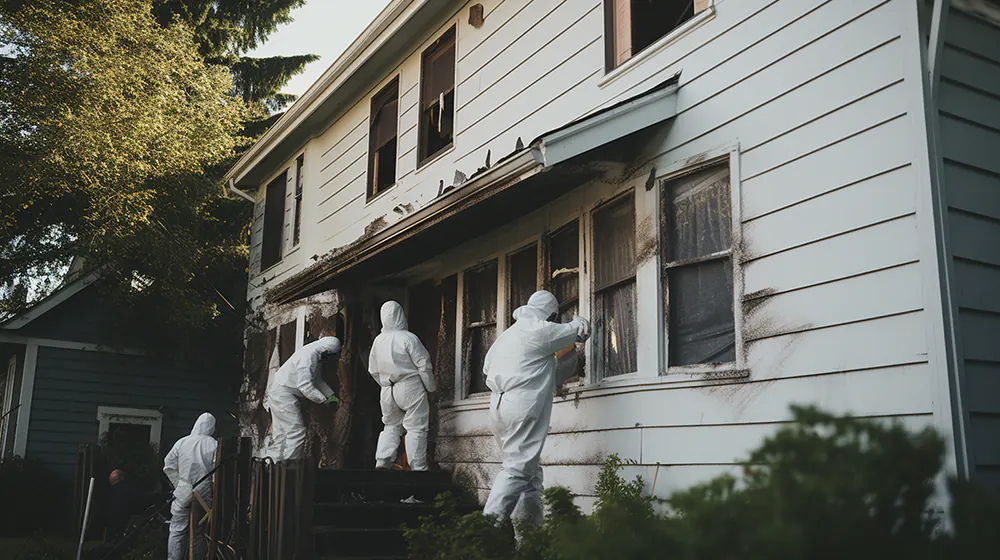How to Find a Good Sidin...
- Mon to Fri: 09:00 am to 07:00 pm

Asbestos siding replacement can be a major undertaking for any homeowner. When done properly, it can add significant value to a home and improve its safety.
However, asbestos removal carries many risks and should only be undertaken by trained professionals.
In this article, we’ll discuss the process of replacing asbestos siding and provide some tips on how to do it safely and effectively.

Asbestos is a type of siding material that consists primarily of asbestos fibers held together by cement creating asbestos shingles. It was used extensively in the 1950s and 1960s as a low-cost and fireproof form of siding and roofing shingles.
However, asbestos cement shingles are now known to be a highly hazardous material when its fibers become airborne and can cause serious health problems if inhaled. As such, asbestos products or asbestos-containing materials have been banned in many countries and it is highly regulated in the United States by the Environmental Protection Agency.
Before starting the process of replacing asbestos siding, it is important to take the necessary steps to prepare for the job. The process to remove asbestos is no easy DIY project. First, it’s important to choose a qualified contractor who is experienced in dealing with asbestos shingle and has all the proper safety equipment and proper PPE procedures in place. This includes wearing protective clothing such as face masks, goggles, and gloves.
Next, it is important to make sure that all the asbestos siding has been removed from the area prior to beginning the replacement process. This includes any nails or screws that may have attached to the old siding. If any of these materials are left behind, they can be a source of contamination and should be disposed of properly.
Finally, it is important to ensure that the area is adequately ventilated and all materials used in the replacement process are non-toxic and not hazardous. Once these steps have been taken, the actual replacement can begin.

The process of removing asbestos siding begins with a thorough inspection of the area. This includes looking for any cracks, holes, or other signs of damage that may indicate where asbestos may be present. Once any damaged areas have been identified, it is important to begin by removing all loose debris and dirt from the area.
Next, a vacuum cleaner should be used to remove any dust particles that may still be present on the house wrap. After this has been done, a scraper or wire brush can be used to remove any visible pieces of asbestos siding.
It is important to take care when doing this, as the particles may still contain asbestos and should not be inhaled. It is also important to wet the area before scraping, as this will help prevent the spread of dust particles.

Once all the old asbestos has been removed, it is important to begin installing the new siding as soon as possible. This should be done in accordance with local building codes and using materials specifically designed for exterior use.
It is also recommended that a vapor barrier be installed between the existing siding and the new siding, as this will help protect against moisture and other forms of damage.
Once the new siding has been installed, it is important to inspect it for any signs of damage or imperfections. If any are found, they should be addressed immediately before continuing with the installation process. Additionally, all hardware used in the installation should be checked to make sure it is properly secured and will not come loose in the future.
Finally, it is important to seal all seams and joints with a special silicone caulk or adhesive to help prevent water damage and maintain an airtight barrier against the exterior environment. This will also provide additional protection against mold growth.
The cost of replacing asbestos siding can vary greatly depending on the size and condition of the existing siding, as well as any additional materials or labor required. Generally speaking, it is estimated that it will cost around $10-$15 per square foot for removal and replacement, plus any other added costs.
Vinyl siding is the most common choice for replacing asbestos siding, as it is durable and relatively easy to install. Other options include fiber cement siding shingles or engineered wood siding. It is important to choose an asbestos-free material that is rated for outdoor use and can withstand the elements.
Yes, there definitely are potential health risks associated with replacing asbestos siding if proper safety precautions are not taken. It is very important to make sure that all materials used in the removal and installation process are non-toxic and that all dust particles are removed from the area before beginning the job. Additionally, it is important to wear protective clothing and use safety equipment such as face masks and goggles to protect against airborne particles.
While it is technically possible to dispose of asbestos siding yourself, it is highly recommended that you hire a professional to do so. Improper handling and disposal can lead to the release of asbestos fibers into the air, which can pose a serious health risk. There are strict regulations in many areas about how asbestos waste should be handled and disposed of, so it’s best to leave this task to the professionals.

The time it takes to replace asbestos siding can vary greatly depending on the size of your home and the extent of the siding that needs to be replaced. On average, it may take between one to two weeks to complete the process. This includes the time required for preparation, removal of the old siding, installation of the new siding, and clean-up.
While asbestos siding can technically be replaced during any time of the year, it is generally recommended to do so during the warmer months. This is because the process of removing and installing siding can expose your home to the elements. Additionally, some siding materials may be affected by extreme cold or heat, so it’s best to plan your siding replacement for a time of year when the weather is more moderate.
Asbestos siding is often found in homes built before the 1980s. It is typically grayish or brown in color and has a distinct, corrugated pattern. Asbestos siding is also known for its durability and fire resistance. However, the only surefire way to identify asbestos is by having a sample tested by a certified laboratory.
If your asbestos siding is in good condition and undisturbed, it generally will not pose a significant health risk. Problems arise when the asbestos fibers are released into the air due to damage or disturbance. Therefore, if your asbestos siding is in good condition, it can often be left in place and monitored for any signs of damage or wear.
If your asbestos siding is in good condition, you may choose to leave it in place and paint over it, or cover it with a new layer of vinyl or aluminum siding. However, any changes should be done by professionals to avoid disturbing the asbestos and releasing the fibers into the air. It’s essential to consult with a professional before deciding on the best course of action.
If you’re living in a home with asbestos siding, it’s important to regularly check for signs of damage or wear. Avoid drilling, sawing, sanding, scraping, or doing anything else that might disturb the siding and release asbestos fibers. If you do notice damage, do not attempt to repair or remove the siding yourself. Instead, contact a professional who is trained in handling asbestos materials.
Asbestos replacement can be a major undertaking for any homeowner. However, with the proper preparation and safety measures in place, it can be done safely and effectively.
It is important to choose a qualified contractor, prepare the area properly, and use non-toxic materials, such as fiber cement shingles or hardwood and safety equipment when replacing asbestos siding.
Additionally, it is important to install a vapor barrier and seal all seams to help protect against moisture damage and ensure an airtight barrier against the exterior environment.
By following these steps, homeowners can be sure that their asbestos siding replacement project will go smoothly and safely.

by Dan Dryer
September 25, 2023